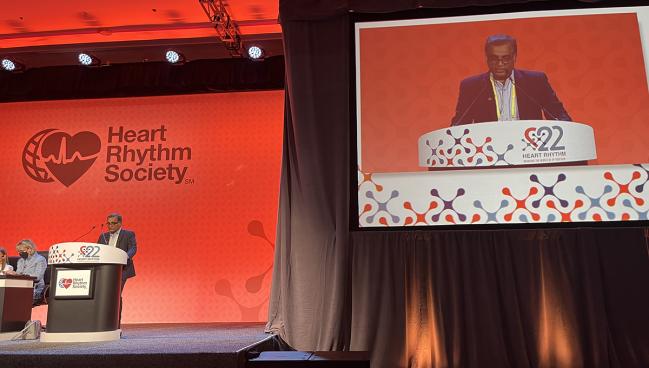Streamlining EP Consult From the ER Pays Dividends in AF
Encouraging earlier contact with an electrophysiologist improved some outcomes and shortened times to definitive treatment.

SAN FRANCISCO, CA—Encouraging referral to an electrophysiologist (EP) as soon as possible after a patient goes to the emergency room with new-onset atrial fibrillation (AF) markedly reduces treatment times and potentially improves clinical outcomes compared with usual care, the nonrandomized ER2EP study suggests.
When emergency physicians triggered early EP consults from the emergency room, either through an entry in the electronic medical record for admitted patients or a faxed referral for those sent home, the median time to evaluation by an EP was just 1 day, compared with 128 days for patients managed with routine procedures (P = 0.001).
The streamlined pathway also led to much shorter times to catheter ablation (52.8 vs 180.6 days) and the initiation of antiarrhythmic drugs (2.7 vs 25.0 days) and oral anticoagulation (1.7 vs 17 days). Patients spent less time in the hospital, too (2.35 vs 5.84 days).
And over 12 months of follow-up, patients managed with the expedited approach had significantly lower rates of emergency room visits for heart-related issues (5% vs 10%) and congestive heart failure (4% vs 8%) plus a reduced number of hospitalizations on average (0.97 vs 1.46).
Reporting the results here at Heart Rhythm 2022, Dhanunjaya Lakkireddy, MD (Kansas City Heart Rhythm Institute and Research Foundation, Overland Park, KS), said “this study provides evidence that having an organized pathway for atrial fibrillation patients can lead to improved outcomes and improved times for A-fib ablations and definitive therapy and [a reduced] length of stay. We hope such guidelines will boost the efficiency of emergency rooms as well as the healthcare systems in the management of atrial fibrillation.”
Speedier Care, Better Outcomes
The emergency department is often the entry point for patients with AF into the healthcare system, Lakkireddy noted. “And when you really look at, historically, how these patients are being managed, there is a tremendous amount of heterogeneity in the paths taken by these people—how many of these patients actually get to see a cardiologist, how many of them actually get to see an electrophysiologist,” he said.
“And how to really standardize care pathways for these people, providing an improved faster access to definitive therapies, is the fundamental premise” of the ER2EP study, Lakkireddy continued. “We believe emergency room physicians have a fantastic opportunity to change the paradigm, not only being able to triage these patients well and provide them acute care, but I think by tweaking their workflow a little bit, we would be able to really accomplish significant short- and long-term outcome differences in patients that have atrial fibrillation.”
We believe emergency room physicians have a fantastic opportunity to change the paradigm. Dhanunjaya Lakkireddy
ER2EP was a multicenter, prospective, observational registry study designed to test that idea in 400 patients with new-onset AF divided equally between hospitals using the streamlined care pathway and those using usual processes. At the hospitals using the new protocol, an automatic EP consultation would be triggered after emergency physicians entered the information into the electronic medical record. For admitted patients, the in-house EP would perform the consult. For those discharged from the emergency department, a referral would be faxed to the EP clinic and follow-up would be performed on an outpatient basis.
There was no concerted effort to contact the EP service in the control hospitals. All of the emergency rooms and associated hospitals had access to the same group of EPs.
The patients in the intervention group had a higher mean age (75.2 vs 72.8 years), were slightly more likely to be men (53% vs 51%), and had a higher rate of nonparoxysmal AF (66.5% vs 27.5%) compared with those in the control group.
As hypothesized, the streamlined pathway led to major reductions in the times to EP evaluation and the initiation of definitive treatments. There was no difference between groups in the average number of clinic visits, but visits to the emergency department and the hospital were lower among patients managed in an expedited fashion. The stroke rate was numerically lower with the intervention (5.5% vs 7.5%) and bleeding complications numerically greater (6.5% vs 3.3%), although neither difference reached statistical significance.
“A very simple intervention that is relatively non-labor-[intensive] can open up an opportunity for patients to get faster and improved care, thereby impacting the short-term as well as the long-term outcomes and really bringing in a paradigm shift in the way we can actually tackle atrial fibrillation,” Lakkireddy said, adding that this approach can help patients “successfully navigate the complexities involved in healthcare delivery.”
‘Clinically Impactful Study’
Lakkireddy acknowledged the limitations of the ER2EP study, including the nonrandomized design, the relatively small sample size, the risk of positive bias stemming from its conduct in high-volume cardiac EP centers, and the presence of more persistent AF in the intervention group.
Thus, larger multicenter studies are needed to confirm the findings, he said.
Discussing the results after Lakkireddy’s presentation, Gregory Marcus, MD (University of California, San Francisco), said this is “very creative and I suspect . . . will prove to be clinically impactful.”
One of the ways I think these data are so valuable is that they will provide good evidence to make a compelling argument to payers and medical systems that there’s actually efficiency there. Gregory Marcus
He, too, noted that caution is needed in interpreting the findings because of the nonrandomized design, adding that some might criticize the use of softer endpoints like time to evaluation and treatment as the main outcomes.
Moreover, the study “opens the door to thinking about so many other similar opportunities,” Marcus said. “We in EP are so fortunate to have many wonderful advances that almost certainly many ER doctors [and] general medicine physicians, are unaware of.”
And this type of approach could be used beyond AF, he suggested, pointing to the possibility of getting patients with supraventricular tachycardia to ablation or having patients with nonischemic cardiomyopathy relieved of frequent premature ventricular complexes or chronic RV pacing sooner than typically occurs.
“One of the ways I think these data are so valuable is that they will provide good evidence to make a compelling argument to payers and medical systems that there’s actually efficiency there, there’s cost savings there,” Marcus said. “And [that] can help to advocate for more support for EPs, whether that’s in the form of [advanced practice providers] or additional administration.”
Todd Neale is the Associate News Editor for TCTMD and a Senior Medical Journalist. He got his start in journalism at …
Read Full BioSources
Lakkireddy D. Impact of an organized treatment pathway on atrial fibrillation patients from the emergency room to electrophysiology service (ER2EP study). Presented at: HRS 2022. April 29, 2022. San Francisco, CA.
Disclosures
- The ER2EP study was funded by an unrestricted research grant from Biosense Webster.
- Lakkireddy reports receiving institutional research grants from Medtronic, Atricure, and Biosense Webster; and consulting or serving on advisory boards for Medtronic, Abbott, Boston Scientific, Atricure, Acutus, Cardiovia, AltaThera Pharmaceuticals, AME, Philips, and Biosense Webster.
- Marcus reports research grants from Baylis Medical Company; consulting fees from Johnson & Johnson, InCarda Therapeutics, and Medtronic; and equity in InCarda Therapeutics.





Comments